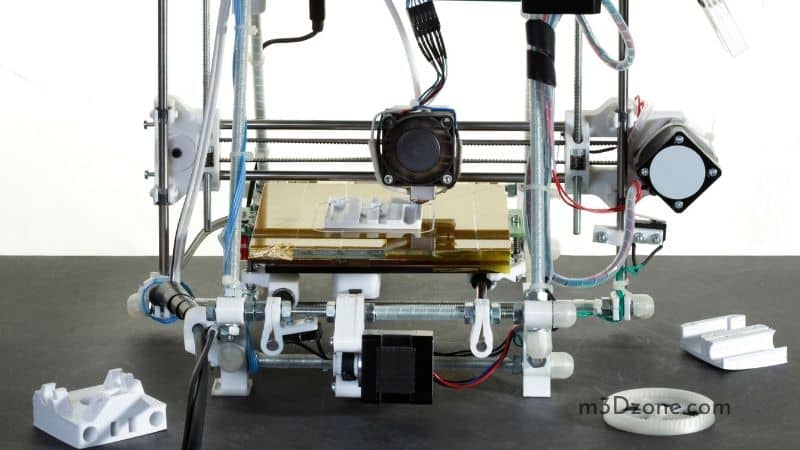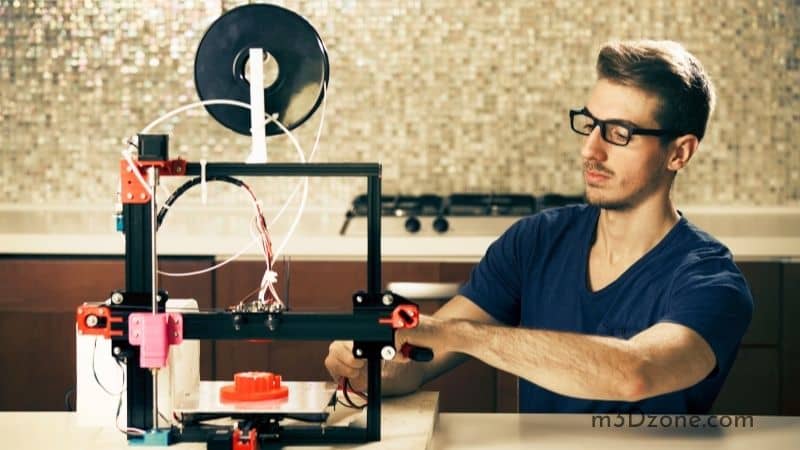Are you looking for the most effective way to clean your glass 3D printer bed? Well, if you don’t regularly clean your 3D printing glass bed, you will end up with serious bed adhesion issues.

As an Amazon Associate, I earn from qualifying purchases. If you make a purchase after clicking on a link I may earn a small commission at no extra cost to you.
Print materials will fail to stick on the print bed, leaving you with deformed 3D prints. If a thin layer of 3D printing filament residue is stuck on the build plate, you may have a challenging time removing it.
Cleaning a glass 3D printer bed requires you to slightly heat the printer bed. You will then apply a cleaning solution of your choice. You can either choose acetone, a mixture of hot water and soap, or a window cleaner. Allow the solution to rest on the printing surface, then wipe it off with paper towels.
Read through this article and learn how you can easily clean the bed.
Quick Navigation
How Do I Clean the Glass on My 3D Printer Bed?
A huge number of 3D printing experts use glass as their preferred bed material. The reason behind this cleaning preference is that a glass plate has a smooth 3D printing surface that helps produce 3D objects that have smooth surfaces.
When experts are using a glass plate in printing, they couple it up with other types of adhesives (check at Amazon). The most common one is inexpensive glue sticks. A hair spray also helps in increasing bed adhesion, making it a competitive alternative.
When you are using a glass 3D printer bed that does not require heating, a glass plate will not have sufficient bed adhesion to ensure the printing filament sticks. You need glue sticks and other adhesives to achieve better adhesion.
The challenge is, these adhesives can be destructive if you don’t remove them from your build plate after completing your 3D printing activities. If you want to avoid uncalled-for damage and losses due to a glue stick, it would be better to clean your glass beds after use.
You can use a couple of different cleaning techniques to clean your glass 3D printer bed. The simplest method is cleaning with a scrapper (check at Amazon). How do you clean with a scraper, you ask?
The first step is raising the glass bed’s temperature to match your filament’s melting point. The filament residues will become soft, giving you an easy time scrapping it off. Be warned, however, that if you are not careful enough, you may damage the print surface when using a sharp scraper.
Whenever you use a scraper but don’t get the desired results, it would help to try a soap and water mixture for cleaning. If you cannot detach your glass beds from your 3D printers, don’t attempt using this method since water damages some components, such as the power supply.
The water you use to clean in this method needs to be warm to soften any ABS, PLA, or PETG plastic filament. The soapy warm water solution is efficient in cleaning a glue stick or hair spray from your borosilicate glass print surface.
Whenever any of the above cleaning methods don’t give satisfactory results, cleaning solutions come to play. The dirt level on the glass bed determines the solution you will use since each material has its unique cleaning process.
Be sure to consult your 3D printer vendor on the best cleaning solutions for your glass 3D printer bed type.
What Do You Clean a Glass 3D Printing Bed With?
You have a few cleaning techniques and materials to use on glass beds, including window cleaner, unscented IPA that is highly concentrated, sterile alcohol pads (check at Amazon), and acetone.
Make sure you don’t use extremely powerful cleaning solutions since they may cause more harm than good to the print surface you are cleaning.
If you are using IPA, make sure it is not less than 70% concentrated. Allow the print beds to cool if you have just finished making 3D prints. You don’t want to get burnt, do you? Now use a paper towel that you have applied your IPA on to clean the printing surface.
Those who decide to use acetone will also need to use a paper towel or a piece of cloth. Apply a sufficient amount of acetone on the cloth and use it to clean the dirty glass surface. You should note that this cleaning method requires a room with conducive air circulation. This is because acetone easily catches fire.
How to Clean Your Ender 3 Bed
3D printing activities often leave printing filament on an Ender 3 bed. For this reason, you must come up with a convenient way to always remove the leftover printing filaments from your Ender 3 bed.
Most people clean the Ender 3 bed with a scrapper. Modern 3D printers come with a scrapper, which eases your cleaning processes.

If you decide to utilize a scrapper, you must be careful where you place your hands and the amount of force you push the tool with. Apply too much force, and you will end up with a damaged printing device or even cut a finger.
Those who have effectively cleaned their Ender 3 beds (check at Amazon) with a scrapper recommend balancing the scrapping force. With one hand on your scrapper’s handle, push the scrapper at the middle using the other hand.
This technique offers better control when cleaning. It would be best if you had your printer to help you make high-quality 3D prints for a long duration, so you have to take care of it. Poor cleaning habits will, over time, leave you with a broken printer.
You can utilize a scrapper and still be left with some thin layers of unwanted filament or dirt on the bed surface. Thin layers are difficult to scrape off, meaning you need a better cleaning strategy.
Sterile alcohol pads and isopropyl alcohol (check at Amazon) with 70% and 75% alcohol concentration levels also come in handy. Any of these is an effective cleaning solution that can eliminate the disturbing dirt leaving you with a spotless printing surface.
Using a cloth and warm water is another technique for dealing with thin layers of filament that are difficult to clean. Warm some water and add soap to it. Now dip a cloth into the soapy mixture and use it to wipe the Ender 3 bed.
Your cleaning cloth only needs to be moist. If it’s too damp, the excess water will drip into your printer’s components, damaging them. You must apply a little pressure with a moist cloth to remove the unwanted material on the Ender 3 bed effectively.
As you apply a little pressure, the soapy water in your cloth or paper towel will work its way through the filament residue. Wiping it off will be easier since it has already been softened.
Every time you make a 3D print, you will likely leave some filament residues on the build plate. Over time, these residues will accumulate to form a more significant piece.
To effectively remove the piece without much hassle is heating the print bed before attempting any removal practice. Heat softens the residue easing its removal using whichever cleaning methods you decide.
Cleaning PLA Off a Glass Bed
If you ask most 3D printer users what filament they use to make posts or parts of objects, most will reply that they utilize a filament that goes by the name polylactic acid (PLA.)
Cleaning PLA material off a glass requires you to utilize the same methods used in cleaning other types of filaments. You can utilize a cleaning solution of your choice, a scrapper, or even soapy water.
A lot of 3D printer users make the mistake of printing their next print over a layer with a similar color. They share the idea that since the two prints share the same color, printing the next print over the previous one will not affect the print’s quality.
Contrary to that, it would be best to clean the glass before making any other prints.
For 3D models whose first filament layer adhesion on the glass bed is sufficient, you can print the next layer on top of an existing residue filament. Your 3D print will still form a considerably good foundation.
To avoid that hassle, it would be best to regularly clean the glass bed. That way, you will not have to worry about the 3D prints you make failing to have a strong foundation. You can utilize something like a razor blade or a glass scraper to clean some of the PLA off your printers.
Cleaning ABS Off a Glass Bed
Cleaning ABS plastic filament requires the use of acetone (check at Amazon). Most people prefer this solution since it easily dissolves ABS filament making it easier to clean.
Allow the solution to rest on the glass bed for about two minutes before using a clean piece of cloth to wipe it off. This process of creating is also convenient since it doesn’t require the application of much force. Additionally, there is no need to heat the printing surface since the ABS is automatically absorbed.
Why Clean Your 3D Printer Bed? (VIDEO)
If you don’t want to keep producing low-quality 3D prints, regular cleaning of this part is a must. The residue will stick on the undesired parts of the prints you are making, giving you shapes that you did not intend to produce.
When you clean these parts in your printers, you no longer have to worry about any prints failing. Clean equipment is always efficient in ensuring you create quality products.
Conclusion
Cleaning a glass 3D printer bed is easy since all you have to use is a glass scraper, soapy water, or other cleaning solutions as discussed in this article. The important thing to note is that you should not apply too much pressure, damaging your 3D printers.
Also, make sure the cleaning solutions are not highly concentrated.
Recommended Reading
Educational 3D Printing. 3D Printers in Education.
In short educational 3D printing refers to using the new technologies in 3D printing explicitly designed to help students learn. Let's find out how!
Can 3D Printing Replace Casting?
Can 3D printing replace casting? In the casting process, molten metal or plastic is poured into a mold with a cavity or hollow with the desired shape.
3D Printing Overhang: Can You 3D Print Overhangs?
3D printing overhang: what is overhang in 3D printing? Overhangs up to 45° can still be printed on 3D printers without losing the quality of the print material.
